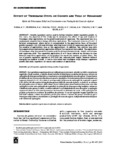Please use this identifier to cite or link to this item:
http://www.alice.cnptia.embrapa.br/alice/handle/doc/1028873| Title: | Effect of Trinexapac-ethyl on growth and yield of sugarcane. |
| Authors: | FARIA, A. T.  FERREIRA, E. A.   ROCHA, P. R. R.   SILVA, D. V.   SILVA, A. A.   FIALHO, C. M. T.   SILVA, A. F.   |
| Affiliation: | ALEXANDRE FERREIRA DA SILVA, CNPMS. |
| Date Issued: | 2015 |
| Citation: | Planta Daninha, Viçosa-MG, v. 33, n. 3, p. 491-497, 2015. |
| Description: | ABSTRACT - Growth regulators can be used to further retard or inhibit vegetative growth. In this sense, the objective of this study was to determine the effects of age and number of trinexapac-ethyl applications on the growth and yield of sugarcane. The experiment was in a randomized complete block design with four replications. The treatments were in a 3 x 2 + 2 factorial arrangement, where factor A corresponded to the application times of the plant growth regulator (120, 200 and 240 days after bud burst (DAB) of sugarcane) and factor B to the number of applications (one or two applications). In addition, two controls (one with three applications and another application without the regulator) were added. The application of trinexapac-ethyl decreased the number and the distance between buds, height, root volume and sugarcane yield. The sequential application (2 or 3 times) induced an increase in stem diameter and three applications of the product increased the number of plant tillers. The use of growth regulators applied at 240 DAB has reduced plant height, however without changing the number of buds. It can be concluded that trinexapac-ethyl changes sugarcane growth and yield, regardless of season and number of applications. RESUMO - Os reguladores vegetais podem ser utilizados para promover, retardar ou inibir o crescimento vegetativo. Neste sentido, o objetivo deste trabalho foi determinar os efeitos de épocas e número de aplicações do trinexapac-ethyl sobre o crescimento e a produtividade da cana-de-açúcar. O experimento foi delineado em blocos casualizados com quatro repetições. Os tratamentos foram arranjados em esquema fatorial (3 x 2 + 2); o fator A correspondeu às épocas de aplicação do regulador vegetal (120, 200 e 240 dias após a brotação das gemas (DAB) da cana-de-açúcar), e o fator B, ao número de aplicações (uma ou duas). Além disso, foram adicionadas duas testemunhas (uma com três aplicações e outra sem aplicação do regulador). A aplicação do trinexapac-ethyl reduziu o número e a distância entre gemas, a altura, o volume radicular e a produtividade da cana-de-açúcar. A aplicação sequencial (duas ou três vezes) promoveu incremento no diâmetro do caule, e três aplicações do produto aumentaram o número de perfilhos das plantas. O uso do regulador vegetal aplicado aos 240 DAB reduziu a altura das plantas, porém sem alterar o número de gemas. Conclui-se que o trinexapac-ethyl altera o crescimento e a produção da cana-de-açúcar, independentemente da época e do número de aplicações. |
| Thesagro: | Época de aplicação Cana de açúcar |
| Keywords: | Regulador vegetal |
| DOI: | 10.1590/S0100-83582015000300011 |
| Type of Material: | Artigo de periódico |
| Access: | openAccess |
| Appears in Collections: | Artigo em periódico indexado (CNPMS)  |
Files in This Item:
| File | Description | Size | Format | |
|---|---|---|---|---|
| Effecttrinexapac.pdf | 215.63 kB | Adobe PDF |  View/Open |









